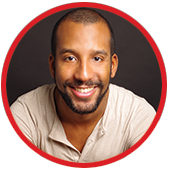 |
ALEXANDER McKENZIE, 32 |
I first heard about PrEP in 2013, when I began working at REZO as a counsellor in the IPERGAY study that proved the effectiveness of PrEP on an on-demand basis among men who have sex with men (MSM). PrEP seemed to be the way of the future with regards to HIV prevention for MSM. I was surprised that more people weren’t talking about it. It seemed like something that everyone should be talking about.
About a year later, I started using PrEP myself. The participants I was counselling for IPERGAY were all men who have condomless sex. When hearing their stories, I thought, “How can I sit here listening to them and counselling them when I could be in their seat?” I realized that I needed to protect myself from HIV and that PrEP could be the best way to do that.
As a man who has sex with men, and as a person of colour, I grew up with the idea that I was the target population for HIV. When I came out to my parents, my mother’s biggest fear was that I was going to get HIV and die of AIDS. Always having that in the back of my mind kind of poisoned my sex life.
For years, even when I used condoms regularly, I felt very anxious waiting to get my HIV test results. For me, the secret side effect of PrEP is that you slowly stop living in fear of HIV.
Now I’m comfortable having sex with people who are HIV positive. I’m more open. First, do I find someone attractive? Let’s go from there. I know that I’ve taken my sexual security into my own hands, so I no longer have to be afraid. I have a much more fulfilling sex life.
PrEP has also made discussions about safer sex easier. I let people know that I use PrEP, which opens up a discussion. That means I get tested every three months. It means that if I choose to not use a condom, I don’t have a fear of becoming HIV positive. It means that I can choose to have more closeness with my partners.
PrEP has made people more open and willing to share with me as well. Often when you’re trying to negotiate a hook-up, if you just go at a person with “when was the last time you were tested?” it can feel like you’re attacking or judging them. But if you say, “here’s how I live my life and this is how I take care of my sexual health,” it’s more of an invitation to have a discussion and it allows the other person to feel more comfortable sharing these things with you. It allows you to make informed decisions about what risk-reduction strategies you can use together.
The thing I see the most in the guys in my practice who use PrEP is a sense of relief. One of the main things people talk to me about is the anxiety they have about sex. Everything about STIs (sexually transmitted infections) freaks them out to the point where people aren’t able to maintain an erection or emotionally connect with someone because they’re not sure if they can trust their partner.
PrEP allows people to feel that they’re doing everything they can to protect their sexual health—not only with regards to HIV but also STIs. People on PrEP who weren’t getting tested for STIs regularly now are. This means that STIs are caught and treated more quickly, which ultimately helps lower the incidence of STIs. As a result, people feel more confident and able to live the sex lives they want.
Things have also changed drastically in the sense that people used to have strong judgments about what kind of people take PrEP. Now, it’s becoming more and more accepted.
Although PrEP is becoming more accessible, the cost remains a barrier. Here in Quebec, even with our health insurance, a person can still end up having to pay $85 to $90 for a month’s worth of medication, if not more. Many people cannot afford that. Studies have shown that having people on PrEP is far more cost-effective than having people become HIV positive.
 |
ABHIRAMI BALACHANDRAN, 24Women’s Sexual Health Coordinator, Alliance for South Asian AIDS Prevention (ASAAP) |
When I first heard about PrEP, my initial reaction was that it sounds like a great idea in theory but I was wary of how accessible it was, especially to people of my demographic group—South-Asian women.
I have never used PrEP myself, mainly because I had never heard of it prior to my working in this role. Unless you are a cis white gay man or part of the HIV sector, PrEP is rarely even brought up.
I inform the women I work with that this option exists, which almost all of them are unaware of. But most women say that they’re not interested in trying it, perhaps because they’re uncertain about the impact it could have on other aspects of their health. Women are also concerned about the stigma they might experience if they ask their doctors about PrEP; they worry they could be seen as engaging in “risky behaviour.”
Healthcare providers need to create safer spaces for women to speak openly about their sexual health, especially PrEP. Access to PrEP needs to be improved substantially, which entails better relationships between service providers and the communities they serve.
There are many barriers to PrEP access—the low usage rates among women, particularly women of colour, are evidence of this. Because PrEP is marketed predominately to gay men, many women are not even aware that this option exists. When you have funders implying that women’s sexual health isn’t a priority, we are left with the misconception that women are not at significant risk, when in reality they are.
PrEP is a feasible alternative for those experiencing intimate partner violence. Sexual violence is commonly overlooked as a significant risk factor and not all women are able to negotiate condom usage. This is not to suggest that PrEP is a solution to their problem, but it can be a good option that they should be aware of.
 |
CHUCK OSBORNE, 67Community researcher |
I first became aware of PrEP in 2012, when I was a treatment outreach worker at Positive Living B.C. People were calling it revolutionary and comparing it to the birth control pill.
This was talked about for quite some time before Truvada was approved as a prevention strategy. People were struggling to get hold of it. But only a few doctors were willing to prescribe it as a prophylaxis before it was approved for PrEP. You know, the gay community is ahead of the curve!
In a very important way, PrEP soon became something I was talking about as a sexually active single gay man who had relationships with positive and negative guys. I like having more options to protect myself and my partners.
PrEP doesn’t protect against other STIs, but it is easy to use. Because it’s a pill, there’s no need for sloppy starts and stops like when using a condom. At this time I have a positive partner, but there’s always the possibility that one day I will be with someone who is HIV negative and PrEP may be needed.
In urban centres, PrEP has now become established conversation, at least among gay men. Since it was approved by Health Canada there seem to be many places where you can access it, but not everyone can afford it.
As a poz person, I take HIV drugs to keep my virus in check and prolong my life. When HIV drugs suppress the virus, they also prevent transmission. In a similar fashion, an HIV-negative person can use PrEP to prevent infection and protect themselves. How can people not see that PrEP is a realistic way of subduing the virus, and that there’s no need to make PrEP users feel shamed and stigmatized?
Do we know the long-term impact of taking PrEP? No, but research shows that it dramatically reduces the risk of contracting HIV.
Studies are also being done on intermittent use, and injectables are in the pipeline, which might prove easier to deal with than pills. But we need to see more awareness that PrEP can be used by people of all genders and identities.
Why not make PrEP available to all those HIV-negative people who consider themselves at risk? With treatment as prevention and U=U (undetectable=untransmittable) for HIV-positive people, we would be better able to reach our goal of ending the epidemic by embracing PrEP.
What is PrEP?
PrEP (pre-exposure prophylaxis) is one of the power tools in the HIV prevention toolbox. PrEP involves an HIV-negative person taking a pill that contains certain HIV drugs to prevent transmission. In 2016, Health Canada approved the use of the HIV drug Truvada (tenofovir + FTC) for PrEP. Less expensive generics are also now available.
When a person takes PrEP consistently as part of ongoing medical care, they dramatically reduce their chance of getting HIV through sex. PrEP is also highly effective at preventing HIV transmission between people who share drug equipment.
To learn more, see the CATIE fact sheet on Oral pre-exposure prophylaxis (PrEP).
